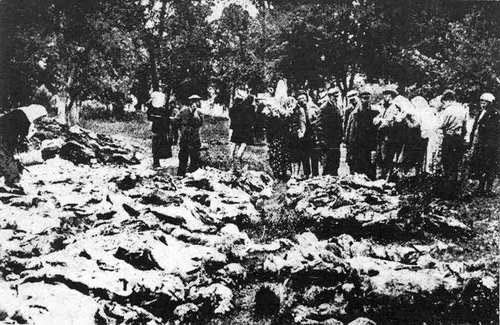
Before the Russian Revolution of 1917, “socialism” and “communism” were synonyms. Both referred to economic systems in which the government owns the means of production. The two terms diverged in meaning largely as a result of the political theory and practice of Vladimir Lenin (1870-1924).
Like most contemporary socialists, Lenin believed that socialism could not be attained without violent revolution. But no one pursued the logic of revolution as rigorously as he. After deciding that violent revolution would not happen spontaneously, Lenin concluded that it must be engineered by a quasi-military party of professional revolutionaries, which he began and led. After realizing that the revolution would have many opponents, Lenin determined that the best way to quell resistance was with what he frankly called “terror”–mass executions, slave labor, and starvation. After seeing that the majority of his countrymen opposed communism even after his military triumph, Lenin concluded that one-party dictatorship must continue until it enjoyed unshakeable popular support. In the chaos of the last years of World War I, Lenin’s tactics proved an effective way to seize and hold power in the former Russian Empire. Socialists who embraced Lenin’s methods became known as “communists” and eventually came to power in China, Eastern Europe, North Korea, Indo-China, and elsewhere.
These are the opening two paragraphs of Bryan Caplan, “Communism,” in David R. Henderson, ed., The Concise Encyclopedia of Economics.
With the 100th anniversary this month of the Communist takeover in Russia, it’s worth reviewing Communism’s record. Caplan does that very well. I recommend the whole piece. Notice also Bryan’s insightful use of production possibility curves to make his point.
Another excerpt explaining how the Communists achieved their grip on power:
The most important fact to understand about the economics of communism is that communist revolutions triumphed only in heavily agricultural societies. Government ownership of the means of production could not, therefore, be achieved by expropriating a few industrialists. Lenin recognized that the government would have to seize the land of tens of millions of peasants, who surely would resist. He tried during the Russian Civil War (1918-1920), but retreated in the face of chaos and five million famine deaths. Lenin’s successor, Joseph Stalin, finished the job a decade later, sending millions of the more affluent peasants (“kulaks”) to Siberian slave labor camps to forestall organized resistance and starving the rest into submission.
The photo above is from “Mass killings under Soviet regimes,” Wikipedia. It shows bodies being uncovered in 1943; the people were killed in Ukraine under Stalin in 1937-38.

READER COMMENTS
Brandon Berg
Nov 17 2017 at 11:02am
In Marxist theory, isn’t communism the stage following socialism, when the state has withered away and workers own the means of production directly?
Had Marxists already abandoned the original definition prior to the Russian Revolution?
TMC
Nov 17 2017 at 5:30pm
Good article. How does fascism differ though. Seems to be the far left sister to socialism and communism. I’ve never read a good distinction between them all.
Mark
Nov 17 2017 at 11:57pm
@TMC,
European fascism takes after the strange (to American minds at least) legacy of right wing socialism. Rodbertus and Josef Maria von Radowitz are examples of this ideology. They were traditionalist monarchists who advocated a rather socialistic conservative paternalism.
American progressives are essentially right that fascism should be characterized as right wing (by European standards) and conservatives are right to note that it was a socialistic ideology. It seems bizarre to Americans, but conservative and socialist aren’t mutually exclusive. Right wing socialists shared leftist admiration for Hegel but not Marxian rejection of social hierarchies. They shared leftist opposition to free trade though (in keeping with rural agrarianism of course).
V. L Elliott
Nov 18 2017 at 9:50am
A problem in today’s discussions of fascism and communism is that in 1920s Germany there was intense competition for control of the socialist movement. The main contestants were fascists, represented by the National Socialists (NAZIs) and the older German communist party. The effects of their respective efforts to establish their differences linger, some because the arguments were picked up by the former Soviet Union’s disinformation apparatus, some because they have been incorporated into the presentations of later socialists. An important issue to me is that both fascists and communists, like other collectivists, begin their reasoning with assumptions that limit the range of individual choice. (This seems to be a key to the arguments about property.) If the question of who chooses is raised at the beginning, I suggest that the Progressive and other collectivist reasoning is challenged.
Richard Fulmer
Nov 19 2017 at 4:34pm
Stephen Hicks’ book, “Explaining Postmodernism,” provides a good explanation of the common roots of and the main differences between, what he calls, left and right socialism. According to Hicks, the key differences are: (1) who should be in charge of the socialist dictatorship (the proletariat or the “volk”), and (2) whether the dictatorship should be international or national.
Though right socialism was destroyed for all practical purposes during World War II, left socialism has drifted toward its positions. Left socialism has largely given up the idea of international revolution, and, with the multicultural left, it has accepted the idea of dictatorship by the volk. It seems to me that the only basic difference between the Alt-Right and America’s hard left is their definition of the volk: whites or the oppressed.
Comments are closed.